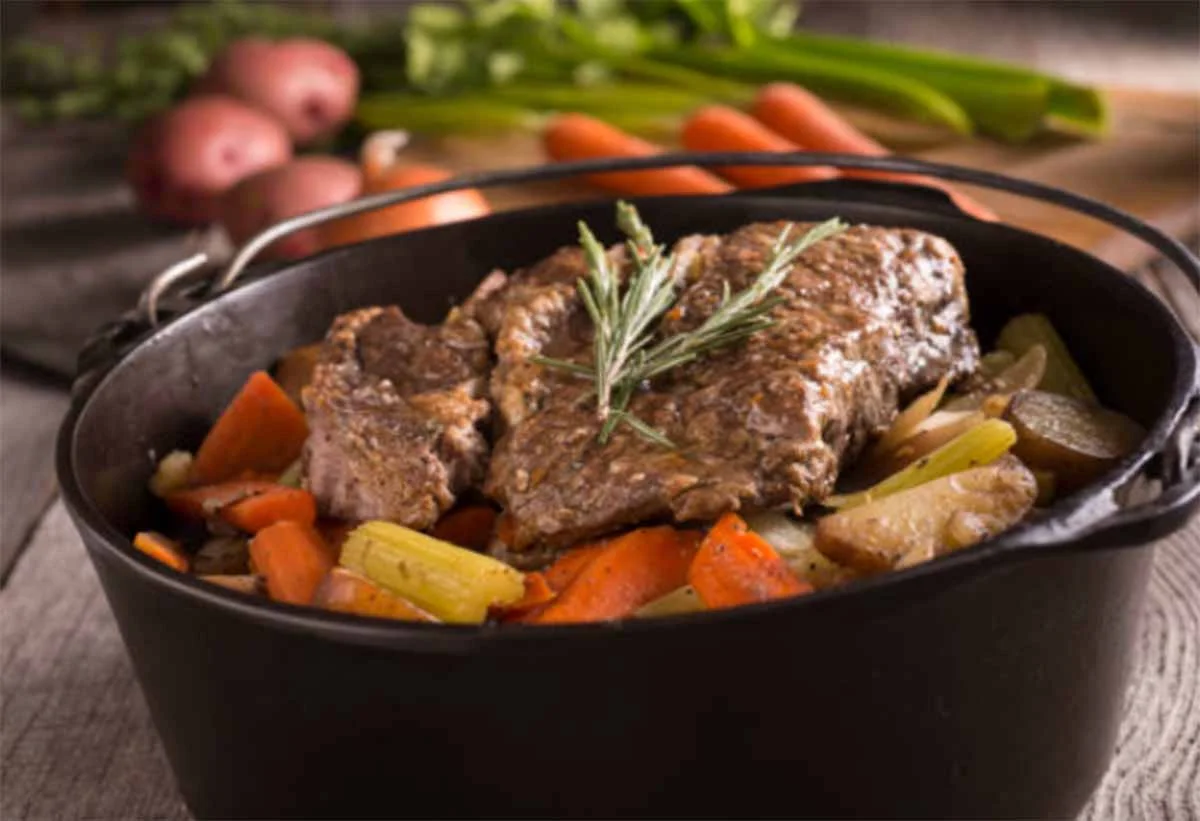Dutch oven roast beef is a mouth-watering dish that is perfect for any occasion. This classic recipe has been around for centuries and is still as popular as ever. The Dutch oven is an essential tool for making this dish as it allows for slow cooking and tenderizing of the beef.
To make Dutch oven roast beef, you will need a few simple ingredients such as beef, vegetables, and herbs. The beef is seared on all sides to create a crispy exterior and then slow-cooked in the Dutch oven with the vegetables and herbs. This allows the beef to absorb all the flavors and become tender and juicy.
Dutch oven roast beef is a versatile dish that can be served with a variety of sides such as mashed potatoes, roasted vegetables, or a fresh salad. It is perfect for family dinners, holiday gatherings, or special occasions. Whether you are an experienced cook or a novice, this recipe is easy to follow and will impress your guests.
Choosing the Right Dutch Oven
When it comes to cooking roast beef, a Dutch oven is an essential tool in any kitchen. However, with so many options available in the market, choosing the right one can be overwhelming. In this section, we will discuss the key factors to consider when selecting a Dutch oven for roast beef.
Size and Material
The size of the Dutch oven is an important consideration. A Dutch oven that is too small will not accommodate the roast beef, while one that is too large will make it difficult to control the cooking temperature. A 6-8 quart Dutch oven is recommended for cooking a 3-4 pound roast beef.
The material of the Dutch oven is another crucial factor to consider. Cast iron is the most popular material for Dutch ovens as it is durable, retains heat well, and distributes heat evenly. However, enameled cast iron is a better option as it is easier to clean and maintain. Stainless steel Dutch ovens are also available, but they are not as effective in retaining heat as cast iron.
Lid Design and Fit
The design and fit of the Dutch oven lid are also important factors to consider. A tight-fitting lid is necessary to prevent moisture from escaping, which can result in a dry roast beef. Additionally, a lid with a knob or handle that can withstand high temperatures is necessary for easy handling.
A Dutch oven with a self-basting lid is also a good option. The lid has raised bumps or spikes that help to distribute moisture evenly over the roast beef, resulting in a tender and juicy roast.
In summary, when selecting a Dutch oven for roast beef, it is important to consider the size, material, and lid design and fit. A 6-8 quart enameled cast iron Dutch oven with a tight-fitting lid and a self-basting feature is recommended for optimal results.
Ingredients for Roast Beef
When it comes to making a delicious Dutch oven roast beef, the ingredients are key. Here are the main ingredients you will need to make a mouth-watering roast beef.
Selecting the Beef Cut
Choosing the right cut of beef is crucial for a tender and flavorful roast beef. The best cuts for roasting are those that come from the hindquarters of the cow, such as the sirloin, round, or rump. These cuts have a good amount of marbling, which helps keep the meat moist during cooking.
Herbs and Spices
To add flavor to the roast beef, a variety of herbs and spices can be used. Some popular herbs include rosemary, thyme, and oregano, while common spices include garlic powder, onion powder, and black pepper. A simple combination of salt and pepper can also do wonders for enhancing the natural flavor of the beef.
Vegetables and Broth
In addition to the beef and seasonings, vegetables and broth are also important ingredients for making a delicious roast beef. Common vegetables used in a Dutch oven roast beef recipe include onions, carrots, and potatoes. These vegetables not only add flavor to the dish, but also help keep the beef moist during cooking. Beef broth or stock is also used to add flavor and moisture to the dish.
By selecting the right cut of beef, using flavorful herbs and spices, and adding vegetables and broth, you can create a delicious Dutch oven roast beef that will impress your guests.
Preparing the Beef
Trimming and Tying
Before cooking a Dutch oven roast beef, it is essential to trim and tie the meat properly. Trimming involves removing any excess fat from the meat, which can prevent it from cooking evenly. It is also important to tie the beef with kitchen twine to help it maintain its shape during cooking. This step ensures that the beef cooks evenly and retains its moisture, resulting in a juicy and tender roast.
Seasoning and Marinating
Seasoning and marinating are crucial steps in preparing a delicious Dutch oven roast beef. The seasoning can be as simple as salt and pepper, or you can use a blend of your favorite spices to add flavor to the meat. It is important to season the beef well, as the seasoning will penetrate the meat during cooking, resulting in a flavorful roast.
Marinating the beef before cooking can also enhance its flavor and tenderness. A marinade can be as simple as a mixture of olive oil, garlic, and herbs, or you can use a more complex marinade recipe. The key is to let the beef marinate for at least a few hours, or overnight, to allow the flavors to penetrate the meat.
Overall, proper preparation of the beef is essential to ensure a delicious and tender Dutch oven roast beef. By trimming and tying the meat properly and seasoning and marinating it well, you can create a flavorful and juicy roast that will impress your guests.
Cooking Process
Searing the Beef
Before placing the beef in the Dutch oven, it is essential to sear it. This process helps to lock in the juices and flavors of the meat. To sear the beef, heat up some oil in the Dutch oven over high heat. Once the oil is hot, add the beef and sear it on all sides until it is browned. This should take about 2-3 minutes per side.
Oven Roasting Steps
After searing the beef, it is time to roast it in the oven. Preheat the oven to 350°F (175°C). Add any desired vegetables and herbs to the Dutch oven around the beef. Cover the Dutch oven with a lid and place it in the oven. Roast the beef for about 20-25 minutes per pound, depending on the desired level of doneness.
It is essential to check the beef’s internal temperature periodically to ensure that it reaches the desired level of doneness. The temperature should be 135°F (57°C) for medium-rare, 145°F (63°C) for medium, and 160°F (71°C) for well done.
Checking for Doneness
To check the beef’s internal temperature, insert a meat thermometer into the thickest part of the meat. Avoid touching the bone, as this can give a false reading. Once the beef has reached the desired temperature, remove it from the oven and let it rest for about 10-15 minutes before slicing. This resting period allows the juices to redistribute throughout the meat, resulting in a juicy and flavorful roast beef.
In summary, searing the beef, oven roasting, and checking for doneness are the essential steps to cook a delicious Dutch oven roast beef. By following these steps, one can achieve a tender and juicy roast beef that is sure to impress.
Resting and Serving
Resting Time
After taking the Dutch oven roast beef out of the oven, it is essential to let it rest for at least 10-15 minutes before carving. This resting time allows the juices to redistribute throughout the meat, resulting in a juicier and more flavorful roast.
To rest the roast beef, place it on a cutting board or a platter and cover it loosely with foil. This will keep the meat warm while allowing excess steam to escape. Avoid covering the roast beef too tightly, as it may cause the meat to continue cooking and become overdone.
Carving and Presentation
Once the roast beef has rested, it’s time to carve and serve. Start by removing any twine or netting that was used to hold the roast together during cooking. Then, using a sharp carving knife, slice the beef against the grain into thin, even slices.
Arrange the slices on a serving platter and garnish with fresh herbs or roasted vegetables for added flavor and visual appeal. Alternatively, serve the roast beef with a side of horseradish sauce or gravy for a classic accompaniment.
When serving the roast beef, be sure to provide a sharp carving knife and fork for guests to use. Encourage them to take only what they need to avoid overeating and food waste.
Overall, resting and serving the Dutch oven roast beef properly is crucial for achieving the best possible flavor and texture. With a little attention to detail and some simple presentation techniques, this classic dish is sure to impress any dinner guest.

